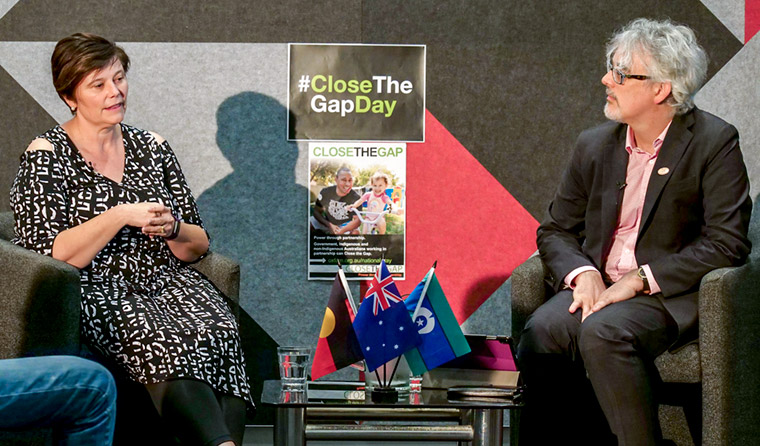News
Close the Gap: Our health, our voice and our choice
This year’s report focuses on positive change and community-driven initiatives.
 This year’s Close the Gap Campaign report highlights ways in which Aboriginal and Torres Strait Islander people are achieving success.
This year’s Close the Gap Campaign report highlights ways in which Aboriginal and Torres Strait Islander people are achieving success.
‘Our health, our voice, our choice’ is the theme of this year’s Close the Gap Campaign report on the progress – or, in the case of many of the targets, lack thereof – of the Council of Australian Governments’ Closing the Gap Strategy.
The 2019 report takes a different approach from previous years, in that it is focused on emphasising positive messages of Aboriginal and Torres Strait Islander success in the health sector rather than the negatives around the progress of the Closing the Gap process.
The Close the Gap Campaign’s report, ‘Our choices, our voices’, which was launched at Tharawal Corporation – Aboriginal Medical Service in south western Sydney, identifies three priority themes that require a strong focus to boost progress in meeting the Closing the Gap targets:
- Targeted, needs-based primary healthcare
- A responsive healthcare system
- Good housing for good health
The report uses examples of successful Aboriginal and Torres Strait Islander-run programs that have been designed to address these issues, including the
Birthing on Country program in New South Wales; the
Winnunga Prison Health Service in Canberra; and the
Yawuru Home Ownership Project in the Northern Territory.
Dr Tanya Schramm, who spoke at the RACGP Close the Gap Day event, is a GP and a Palawa woman who lectures in Aboriginal and Torres Strait Islander health at the University of Tasmania.
Although she has faced a lot of challenges in the course of her career, such as being told as a young person that being a doctor ‘wasn’t for me, people like me don’t do things like that’, she has also seen a lot of positive change in the field of Aboriginal health.
‘When I finished [at Newcastle University], we took the numbers for Indigenous doctors from single figures into double figures for the first time,’ Dr Schramm told
newsGP. ‘And now I think there’s something like over 400 medical students and doctors in the country.
‘We’ve grown quite immensely in all those years, and through the time I’ve been working as a doctor there’s been some huge changes. It’s been really amazing to be part of such a huge change.’
 Dr Tanya Schramm and Dr Tim Senior during a question and answer session at the RACGP for Close the Gap Day.
Dr Tanya Schramm and Dr Tim Senior during a question and answer session at the RACGP for Close the Gap Day.
Dr Schramm agrees it is vital that any initiative designed for the Aboriginal and Torres Strait Islander community must be done ‘with’ the community, rather than ‘to’ it.
‘The [previous] tendency was to go in and say, “We know how to fix this problem, here’s the pool of money and this is what you’re going to do”,’ she said. ‘And obviously those sorts of projects have often fallen over and not worked.
‘The reality is, if you sit down with the community and ask what their priorities and problems are and how can we address them, the community can give you some ideas that can be put into a program.
‘And because the community have had input into it, they have an interest in it as well, and therefore it’s more likely to succeed because it’s what they actually wanted.’
Dr Schramm points to Aboriginal Community Controlled Health Services (ACCHS) as a proven example of the success that comes with people being involved.
‘Their strength is that, as it says, they are community-controlled,’ she said. ‘They’re developed by the community, for the community.
‘So that’s the power behind them – the community have a say in how their health service is run, the programs and how it’s all going to work ... [ACCHSs] set themselves up to address the needs of Aboriginal people and health, and they’re culturally safe, competent services for people to go to.’
Dr Tim Senior, Medical Advisor for RACGP Aboriginal and Torres Strait Islander Health, also spoke at this week’s event, emphasising the need for non-Indigenous Australians to truly consult with Aboriginal and Torres Strait Islander communities about what is needed to close health gaps.
‘We actually have to do much more listening than talking, particularly around issues of cultural safety.
‘This is not up to us to decide or judge, this is up to thousands of local communities around Australia to decide and judge if we are getting this right,’ Dr Senior said.
‘And then listen, and act on that.’
Aboriginal and Torres Strait Islander health Close the Gap
newsGP weekly poll
How often do patients ask you about weight-loss medications such as semaglutide or tirzepatide?